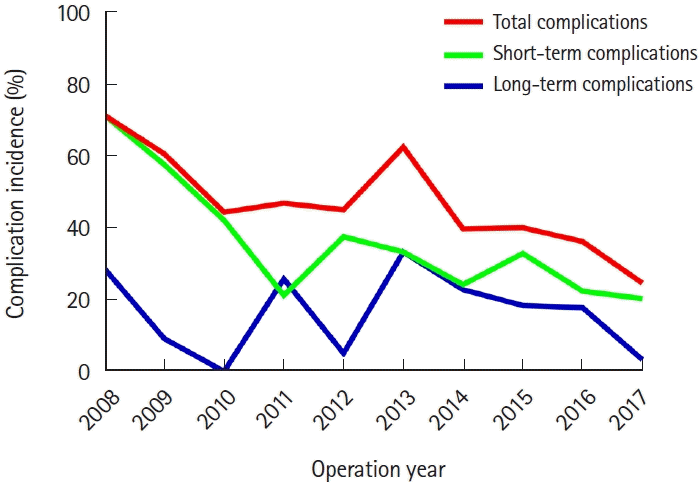1. Rubin DT, Ananthakrishnan AN, Siegel CA, Sauer BG, Long MD. ACG clinical guideline: ulcerative colitis in adults. Am J Gastroenterol. 2019; 114:384–413.

2. Hindryckx P, Jairath V, D’Haens G. Acute severe ulcerative colitis: from pathophysiology to clinical management. Nat Rev Gastroenterol Hepatol. 2016; 13:654–664.

3. Jeuring SF, Bours PH, Zeegers MP, et al. Disease outcome of ulcerative colitis in an era of changing treatment strategies: results from the Dutch population-based IBDSL cohort. J Crohns Colitis. 2015; 9:837–845.

4. Parragi L, Fournier N, Zeitz J, et al. Colectomy rates in ulcerative colitis are low and decreasing: 10-year follow-up data from the Swiss IBD cohort study. J Crohns Colitis. 2018; 12:811–818.
5. Parks AG, Nicholls RJ. Proctocolectomy without ileostomy for ulcerative colitis. Br Med J. 1978; 2:85–88.

6. Fu W, Zhang T, Zhang Z. The application of total proctocolectomy and ileal pouch-anal anastomosis in the treatment of ulcerative colitis. Chin J Gastrointest Surg. 1999; 4:208–210.
7. Han HQ, Liu G, Liu T, Lü YC, Fu Q. Clinical evaluation of restorative proctocolectomy with ileal pouch-anal anastomosis for ulcerative colitis. Zhonghua Yi Xue Za Zhi. 2011; 91:3205–3209.
8. Cui L. Treatment of ulcerative colitis by total colectomy ileal pouch-anal anastomosis. Zhonghua Wei Chang Wai Ke Za Zhi. 2012; 15:1221–1223.
9. Liu G, Han H, Liu T, Fu Q, Lyu Y. Clinical outcome of ileal pouchanal anastomosis for chronic ulcerative colitis in China. Chin Med J (Engl). 2014; 127:1497–1503.
10. Candido FD, Fiorino G, Spadaccini M, Danese S, Spinelli A. Are surgical rates decreasing in the biological era in IBD? Curr Drug Targets. 2019; 20:1356–1362.

11. Wong DJ, Roth EM, Feuerstein JD, Poylin VY. Surgery in the age of biologics. Gastroenterol Rep (Oxf). 2019; 7:77–90.

12. Abelson JS, Michelassi F, Mao J, Sedrakyan A, Yeo H. Higher surgical morbidity for ulcerative colitis patients in the era of biologics. Ann Surg. 2018; 268:311–317.

13. Justiniano CF, Aquina CT, Becerra AZ, et al. Postoperative mortality after nonelective surgery for inflammatory bowel disease patients in the era of biologics. Ann Surg. 2019; 269:686–691.

14. Bikhchandani J, Polites SF, Wagie AE, Habermann EB, Cima RR. National trends of 3- versus 2-stage restorative proctocolectomy for chronic ulcerative colitis. Dis Colon Rectum. 2015; 58:199–204.

15. de Buck van Overstraeten A, Mark-Christensen A, Wasmann KA, et al. Transanal versus transabdominal minimally invasive (completion) proctectomy with ileal pouch-anal anastomosis in ulcerative colitis: a comparative study. Ann Surg. 2017; 266:878–883.
16. Satsangi J, Silverberg MS, Vermeire S, Colombel JF. The Montreal classification of inflammatory bowel disease: controversies, consensus, and implications. Gut. 2006; 55:749–753.

17. Truelove SC, Witts LJ. Cortisone in ulcerative colitis; final report on a therapeutic trial. Br Med J. 1955; 2:1041–1048.
18. Ng SC, Shi HY, Hamidi N, et al. Worldwide incidence and prevalence of inflammatory bowel disease in the 21st century: a systematic review of population-based studies. Lancet. 2017; 390:2769–2778.

19. Ordás I, Domènech E, Mañosa M, et al. Post-operative morbidity and mortality of a cohort of steroid refractory acute severe ulcerative colitis: nationwide multicenter study of the GETECCU ENEIDA Registry. Am J Gastroenterol. 2018; 113:1009–1016.

20. Peyrin-Biroulet L, Germain A, Patel AS, Lindsay JO. Systematic review: outcomes and post-operative complications following colectomy for ulcerative colitis. Aliment Pharmacol Ther. 2016; 44:807–816.
21. Yu Q, Mao R, Lian L, et al. Surgical management of inflammatory bowel disease in China: a systematic review of two decades. Intest Res. 2016; 14:322–332.

22. Masaki T, Kishiki T, Kojima K, Asou N, Beniya A, Matsuoka H. Recent trends (2016-2017) in the treatment of inflammatory bowel disease. Ann Gastroenterol Surg. 2018; 2:282–288.

23. Subramanian V, Saxena S, Kang JY, Pollok RC. Preoperative steroid use and risk of postoperative complications in patients with inflammatory bowel disease undergoing abdominal surgery. Am J Gastroenterol. 2008; 103:2373–2381.

24. Zittan E, Milgrom R, Ma GW, et al. Preoperative anti-tumor necrosis factor therapy in patients with ulcerative colitis is not associated with an increased risk of infectious and noninfectious complications after ileal pouch-anal anastomosis. Inflamm Bowel Dis. 2016; 22:2442–2447.

25. Kurnool S, Nguyen NH, Proudfoot J, et al. High body mass index is associated with increased risk of treatment failure and surgery in biologic-treated patients with ulcerative colitis. Aliment Pharmacol Ther. 2018; 47:1472–1479.

26. Wu XJ, He XS, Zhou XY, Zou YF, Lan P. Safety and feasibility of laparoscopic surgery and open surgery in ulcerative colitis: a meta-analysis. Zhonghua Wei Chang Wai Ke Za Zhi. 2008; 11:408–413.
27. Causey MW, Stoddard D, Johnson EK, et al. Laparoscopy impacts outcomes favorably following colectomy for ulcerative colitis: a critical analysis of the ACS-NSQIP database. Surg Endosc. 2013; 27:603–609.

28. Tajti J Jr, Látos M, Farkas K, et al. Effect of laparoscopic surgery on quality of life in ulcerative colitis. J Laparoendosc Adv Surg Tech A. 2018; 28:833–838.

29. Mège D, Figueiredo MN, Manceau G, Maggiori L, Bouhnik Y, Panis Y. Three-stage laparoscopic ileal pouch-anal anastomosis is the best approach for high-risk patients with inflammatory bowel disease: an analysis of 185 consecutive patients. J Crohns Colitis. 2016; 10:898–904.

30. Lee GC, Deery SE, Kunitake H, et al. Comparable perioperative outcomes, long-term outcomes, and quality of life in a retrospective analysis of ulcerative colitis patients following 2-stage versus 3-stage proctocolectomy with ileal pouch-anal anastomosis. Int J Colorectal Dis. 2019; 34:491–499.

31. Lavryk OA, Stocchi L, Hull TL, et al. Impact of preoperative duration of ulcerative colitis on long-term outcomes of restorative proctocolectomy. Int J Colorectal Dis. 2020; 35:41–49.






 PDF
PDF Citation
Citation Print
Print



 XML Download
XML Download